Czech anti-tank, mountain and field guns in the armed forces of Nazi Germany
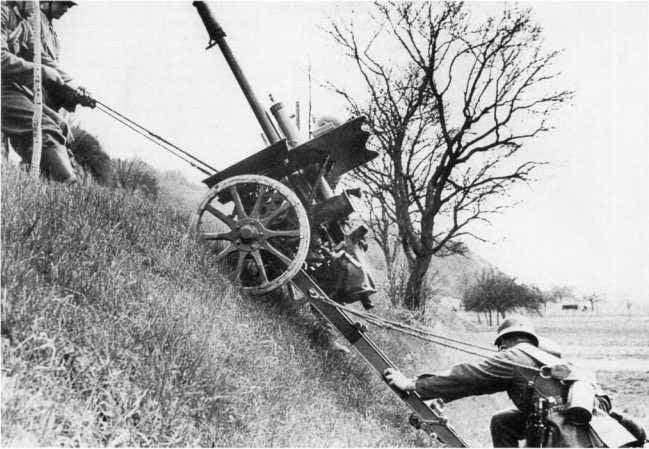
After the annexation of Czechoslovakia, the German army captured several thousand anti-tank, field and mountain guns, many of which met the highest world standards in terms of workmanship and combat characteristics. During the Second World War, military factories located on the territory of the protectorate of Bohemia and Moravia produced artillery systems and ammunition for the armed forces of the Third Reich.
Anti-tank guns
In the context of a chronic shortage of anti-tank artillery, the armed forces of Nazi Germany actively used guns captured in other countries. A very significant part of the anti-tank guns available in the Wehrmacht in the initial period of the war was of Czech production.
As of March 1939, anti-tank defense in the Czechoslovak army was provided by 37 mm 3.7 cm kanon PUV guns. vz. 34 (Škoda vz. 34 UV), 3.7 cm canon PUV. vz. 37 and 47mm 4.7cm kanon PUV. vz. 36.
In the early 1930s, 37 mm guns were considered quite suitable for combating tankswith bulletproof armor. In this regard, anti-tank guns of this caliber have become widespread.
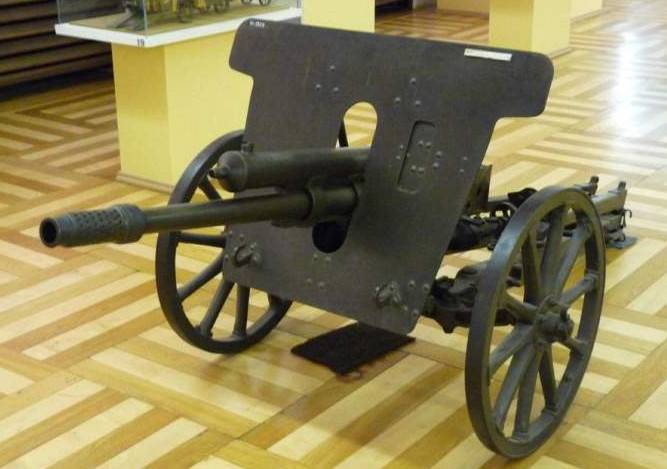
37 mm anti-tank gun 3.7 cm kanon PUV. vz. 34 in the exposition of the Military Museum of Prague
The 37 mm 3.7 cm kanon PUV anti-tank gun was considered one of the best. vz. 34 (brand name Škoda A3), which had a small mass and modest dimensions. This tool was quite perfect for its time.
The mass in combat position was 364 kg. The 37 mm gun had a monoblock barrel with a horizontal wedge breech, which provided a rate of fire of 15–20 rounds per minute. The ammunition included an armor-piercing projectile weighing 0,85 kg and a fragmentation projectile weighing 1,2 kg. An armor-piercing projectile at a distance of 100 m could normally penetrate 42 mm armor, at a distance of 500 m armor penetration was 31 mm.
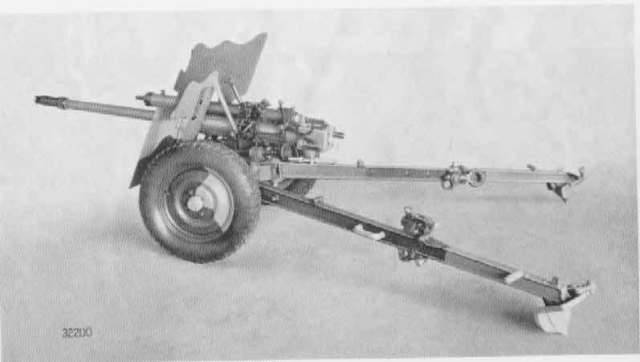
Wooden wheels with a metal rim were sprung, which made it possible to transport the gun not only by horses, but also by mechanical traction. Part of guns 3.7 cm kanon PUV. vz. 34, intended for anti-tank batteries of motorized divisions, had wheels with pneumatic tires, which made it possible to tow at speeds up to 60 km / h.
Gun 3.7 cm kanon PUV. vz. 37 was different from the mod. 1934 carriage design and barrel length 1 mm. On the tools mod. 770 and arr. In 1934, a 1937-mm anti-fragmentation shield was installed. Due to the longer barrel, armor penetration is 5 cm kanon PUV. vz. 3.7 has increased significantly. At a distance of 37 m, an improved armor-piercing projectile with a carbide tip could normally penetrate 100 mm armor. At a distance of 54 m, penetration was 500 mm.
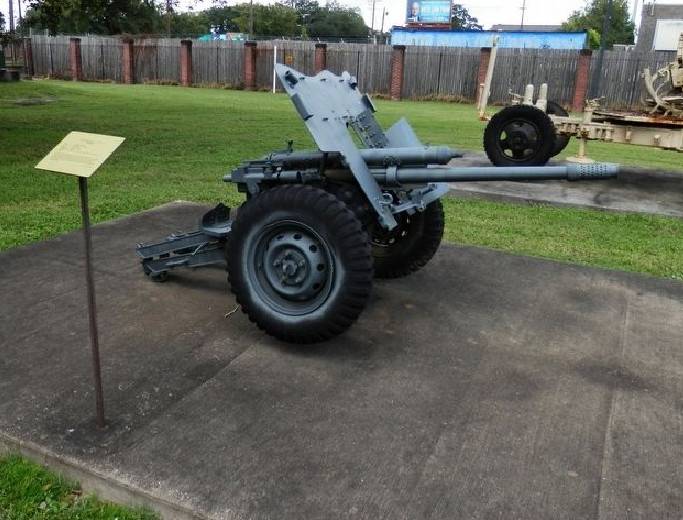
37 mm anti-tank gun 3.7 cm kanon PUV. vz. 37 in the museum exhibition
The Germans, having appreciated the combat qualities of the Czech guns, adopted them under the designation 3,7-cm Pak. 34(t) and 3,7cm Pak. 37(t). Already after the loss of independence, the Skoda factories supplied the Wehrmacht with 513 37-mm anti-tank guns.
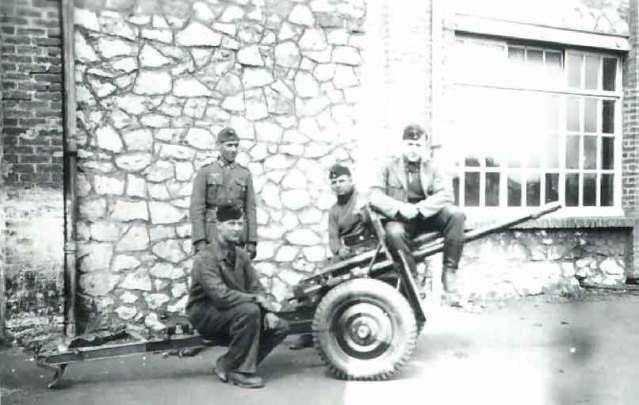
German soldiers with a 37 mm 3.7 cm kanon PUV gun. vz. 37 equipped with wheels with pneumatic tires
The guns produced after the occupation had wheels with pneumatic tires, which made it possible to increase the speed of their transportation. Some of the 37-mm cannons inherited from the Czechoslovak army were also equipped with such wheels in army workshops.
Czech-made 37mm anti-tank guns on a par with German Pak guns. 35/36 in the initial period of the war were used in anti-tank battalions of infantry divisions. However, soon after the invasion of the USSR, it became clear that the armor penetration of 37-mm guns and the armored effect of their shells on modern medium and heavy tanks left much to be desired, and they were quickly replaced in the first line units by more effective anti-tank weapons. Nevertheless, at the beginning of 1945, the Wehrmacht still had 88 3,7-cm Pak 37 (t) guns in secondary directions.
The designers of the Skoda firm understood that with the growth of the protection of tanks, 37-mm guns would soon become irrelevant. In 1936, tests began on a 47-mm towed anti-tank gun (brand name Škoda A5), which had a barrel of a 47-mm fortress gun. A significant innovation was a fully swivel upper machine - in the stowed position it turned 180 °, and the barrel was fixed to the reduced beds.
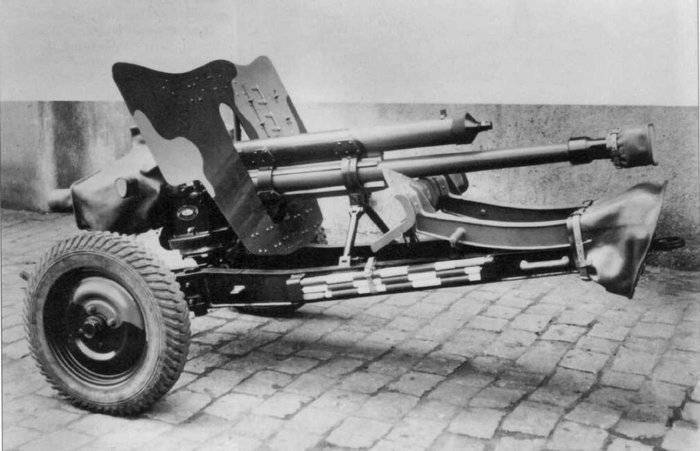
47 mm anti-tank gun 4.7 cm kanon PUV. vz. 36 in the stowed position
The wheel drive was detachable - fire could be fired both from the wheels and from the support platform. The two-section gun shield with a thickness of 4,7 mm was made easily removable. And the whole gun could be easily disassembled into several parts for carrying. Although the 47mm gun weighed almost twice as much as the 3.7cm kanon PUV. vz. 34, the possibility of towing guns on the battlefield by crew forces was also retained. The mass of the gun in combat position was 580 kg.
As in the case of the 37 mm guns, the 47 mm gun had three variants that differed in the design of the wheels and frames. For use in infantry divisions and fortified areas, guns with wooden wheels and folding beds were intended, which were towed by horse traction. But if one horse was enough for a 37-mm gun, then two horses pulled a 47-mm one, harnessed by a train. The cavalry variant was distinguished by disc-shaped metal wheels with pneumatics and non-folding beds. The carriage of the gun was carried out by a four-horse team. Modification for motorized units had wheels, like a cavalry gun, but folding beds.
After being put into service in the fall of 1938, the 47 mm gun received the designation 4.7 cm kanon PUV. vz. 36.
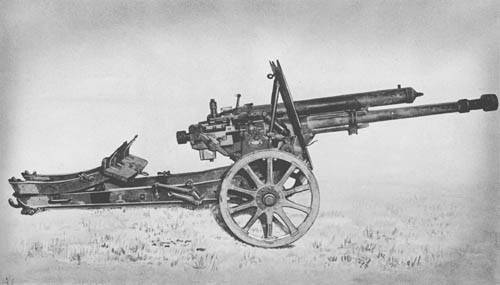
47 mm anti-tank gun 4.7 cm kanon PUV. vz. 36
At the time of the start of mass production, the 47-mm anti-tank gun was one of the most powerful artillery systems for this purpose. With a barrel length of 2 mm, the muzzle velocity of a 240 kg armor-piercing projectile was 1,65 m/s. At a range of 775 m at a right angle, he pierced 1-mm armor. Also, the ammunition included a shot with a 000-kg fragmentation grenade - thanks to which the gun could be successfully used to destroy firing points and enemy manpower. A well-trained calculation could make 55 aimed shots per minute.
The Skoda company managed to manufacture 298 serial 47-mm anti-tank guns for Yugoslavia. Beginning in April 1941, captured Yugoslav guns were operated by the Germans under the designation 4,7 cm Pak 179(j). A certain number of Yugoslav guns were received by the Italians, who used them in 1943 in the battles in Sicily. In the German armed forces, the 47-mm Czech anti-tank gun had the designation 4,7 cm Pak (t), the designation 4,7 cm Pak 36 (t) is also found.
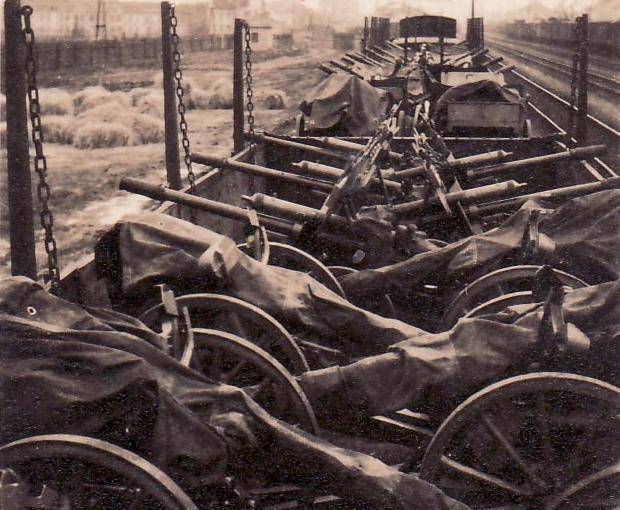
The first batch of 47-mm guns from the former Czechoslovak order in the amount of 51 units was accepted by the German army in 1939. In 1940, 202 guns were handed over to the Wehrmacht, in 1941 - 269, in 1942 - 68 copies. Thus, the German armed forces received a total of 590 4,7 cm Pak (t) guns.
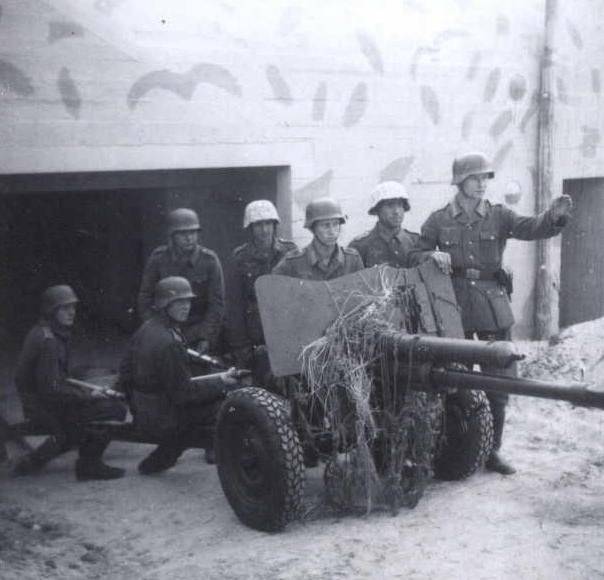
From the middle of 1939, 4,7 cm Pak (t) guns began to enter the tank destroyer divisions of a number of German infantry divisions. Their baptism of fire took place in France in 1940, where the 4,7 cm Pak(t) outperformed the 3,7 cm Pak. 35/36. In terms of armor penetration, the 47 mm Czech-made gun was slightly inferior to the 50 mm German 5 cm Pak. 38, which during the French campaign there were very few in the troops.
In 1940, the PzGr 47 armor-piercing sub-caliber projectile with a tungsten carbide core was introduced into the ammunition load of the 40-mm gun. A projectile weighing 0,8 kg, with an initial speed of 1 m/s at a distance of up to 080 m, confidently pierced the frontal armor of a medium Soviet T-500 tank. This made the 34 cm Pak(t) gun relevant until mid-4,7, when the German anti-tank battalions were equipped with a sufficient number of 1943 mm and 50 mm guns. However, due to the shortage of tungsten, the proportion of sub-caliber shells in the ammunition load was small, and they turned out to be effective only at a relatively short distance.
To increase the mobility of anti-tank units, self-propelled artillery mounts were armed with 47-mm Czech guns.
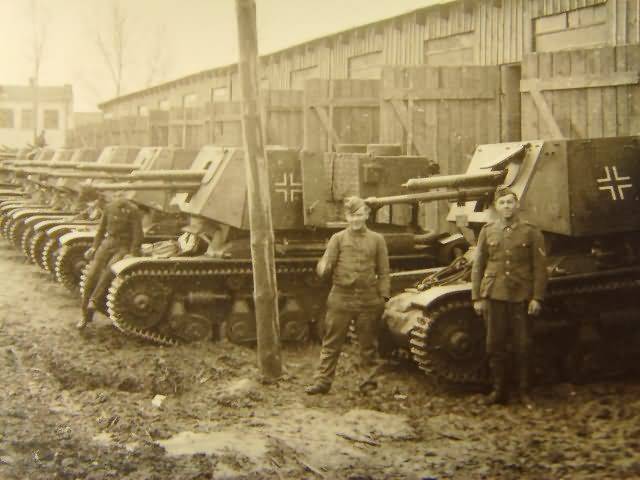
Tank Destroyer Panzerjäger 35 R (f)
In March 1940, the 4,7 cm Pak 36(t) was mounted on the chassis of the German light tank Pz. Kpfw. I Ausf.B, and since May 1941 - on the chassis of a captured French R-35 tank. A total of 376 light tank destroyers were manufactured. Self-propelled guns, designated Panzerjager I and Panzerjager 35 R (f), as well as towed 47-mm guns, entered service with tank destroyer divisions.
mountain tools
In 1915, a 75-mm mountain gun 7,5 cm GebK 15 (7,5 cm Gebirgskanone M 15) was created in the design office of the Škoda enterprise in Pilsen. Until the end of the First World War, the production of these guns was carried out at production facilities in the Czech Pilsen and the Hungarian Gyor. Until the end of production in 1918, more than 2 guns were produced.
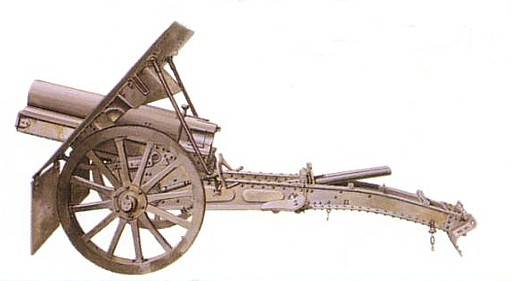
75 mm gun 7,5 cm GebK 15
The mass of the gun in combat position was 613 kg. Barrel length - 1 mm. Shots 115x75 mm R were used for firing. A fragmentation grenade weighing 129 kg left the barrel with an initial speed of 6,35 m / s. The maximum firing range is 350 m. Elevation angles: from -8° to +200°. Rate of fire up to 10 rds / min. The gun could be dismantled into parts suitable for transportation in packs.
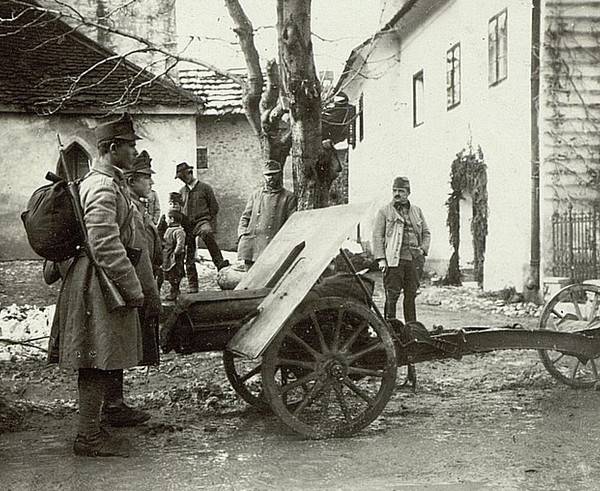
Austrian soldiers with a 7,5 cm GebK 15 gun
After the collapse of the Austro-Hungarian Empire, 7,5 cm GebK 15 guns were available in Austria, Bulgaria, Czechoslovakia, Germany, Hungary, Italy, Romania, Turkey, Poland and Yugoslavia.
By inheritance from Austria-Hungary, the Czechoslovaks inherited 58 guns, to which were then added another 240, produced in Pilsen from 1921 to 1924. In the Czechoslovak army, these guns were called 7,5 cm horský kanon vz. 15.
The GebK 15 fleet in the Third Reich was replenished with Austrian and Czechoslovak guns and amounted to 254 units. The guns that previously belonged to the Austrian army received the designation GebK 15 (ö), and the Czech - GebK 15 (t). In 1941, they were joined by guns captured from the Yugoslav army, designated GebK 259 (j), and in 1943 - the Italian GebK 259 (i). In the Wehrmacht, artillery regiments attached to mountain infantry divisions were equipped with 75-mm GebK 15 guns.
The artillery regiment included four divisions, two of which (two batteries each) were equipped with 75-mm mountain guns. Artillery regiments of light infantry divisions had a similar organization. In addition, GebK 15s entered the airborne units. However, most often 75-mm mountain guns were used as field guns. In this role, they were not very good. The firing range left much to be desired, and the wheel travel did not allow towing at high speed.
Based on 7,5 cm horský kanon vz. 15 in 1928, a 75 mm Skoda M. 28 mountain gun was created for export. A total of 75 guns were fired.
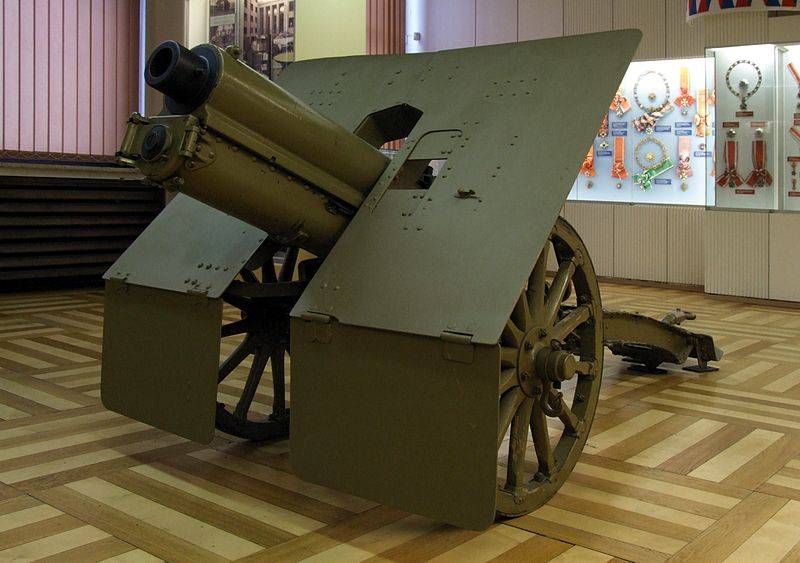
75-mm mountain gun 75 mm Skoda M. 28 in the exposition of the Military Museum of Prague
The gun with a 75 mm barrel and shield weighed 716 kg. Barrel length - 1 mm. Elevation angles: -345° to +10°. Firing range - up to 50 m.
Most of the 75 mm Skoda M. 28 guns inherited by the Germans were captured in Yugoslavia, in the Wehrmacht they were called 7.5 cm GebK 285 (j).
Field guns
In the 1920s, the main field artillery weapon in the Czechoslovak army was the 76,5 mm Austrian 8 cm FK M. 17 cannon (8 cm Feldkanone M 17), renamed 8 cm kanon vz. 17.
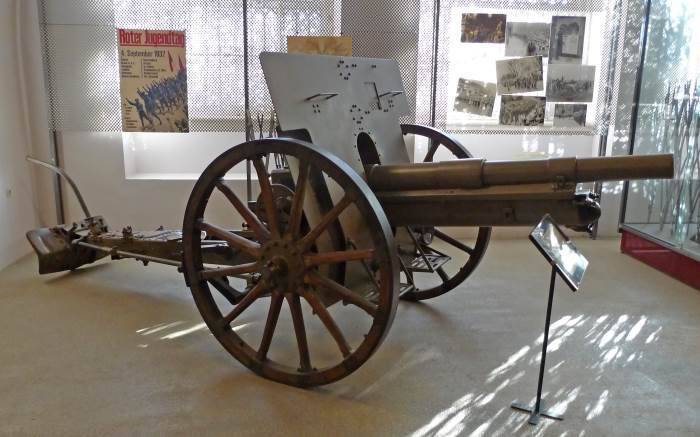
76,5 mm field gun 8 cm FK M. 17 in the museum exposition
This gun was created taking into account the experience of using the Austrian field gun 8 cm FK M. 05. The mass in combat position was 1 kg. Barrel length - 319 mm. Elevation angles: -2° to +078°. The maximum firing range of a 10-kg projectile was 45 m. When firing a fragmentation grenade weighing 6,7 kg, it was 11 m. The rate of fire was 400 rds / min.
Such guns, in addition to Czechoslovakia, became the trophies of German troops in Austria, Poland and Yugoslavia. Czechoslovak field guns received the German designation 7,65 cm FK 17(t).
The 8 cm FK M. 17 field gun, compared to the 8 cm FK M. 05 with a steel-bronze barrel, was certainly more advanced, but, being a typical design of the First World War era, it was already considered obsolete 10 years after its creation. The military was not satisfied with the relatively small firing range and the lack of modernization prospects. At the same time, in the 1920s, the Czechoslovak Ministry of National Defense did not have sufficient financial resources, and the military tended to observe how the Skoda company developed export samples at its own expense, and from the side to evaluate their suitability for adoption.
In 1928, Yugoslavia signed a contract for the supply of three hundred 76,5 mm universal guns M. 28. An order from Romania soon followed for 96 guns of the 75 mm Tunul de camp Skoda, cal. 75mm, md. 1928, which differed from the M. 28 in caliber, but had a similar design.
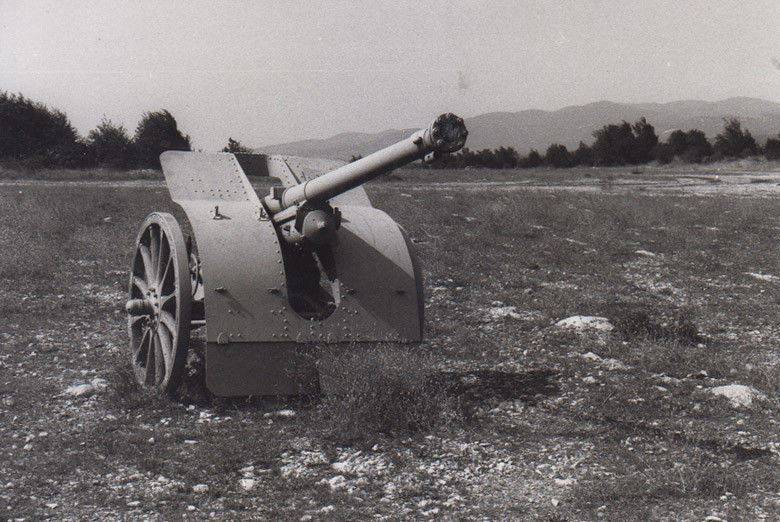
Yugoslav 76,5 mm gun M. 28
The M. 28 cannon was developed as part of a concept popular in the 1920s–1930s, in which it was supposed to have a multi-purpose gun that could be used as a field, mountain, anti-tank and anti-aircraft gun. For firing at air targets, the gun was mounted on a swivel metal base, and anti-aircraft fire control devices were to be included in the battery.
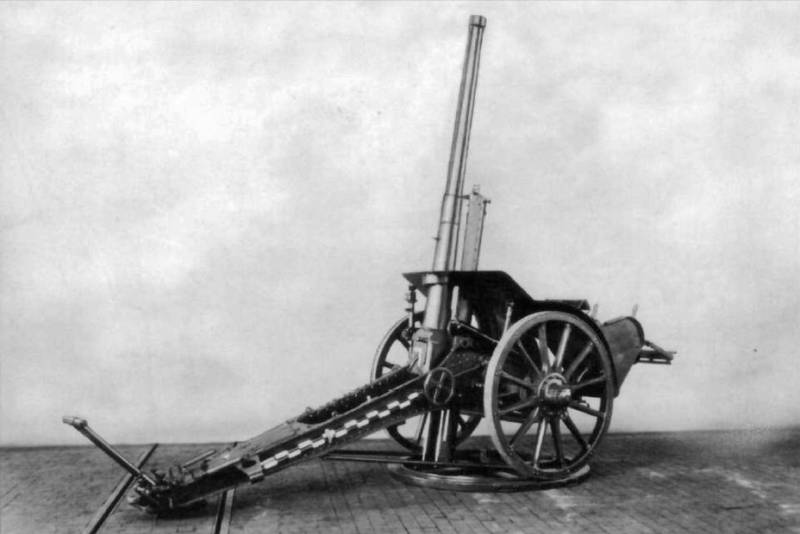
Naturally, it was not possible to successfully solve all the tasks set during the creation of this artillery system, and attempts to combine conflicting requirements led to an increase in the cost and weight of the structure. Thus, the 76,5-mm universal gun M. 28 turned out to be completely untenable as an anti-aircraft gun, but it was not bad as a field and partly mountain gun. Due to the limited angles of horizontal guidance, this artillery system was of little use for combating armored vehicles.
The weight in combat position was 1 kg. Barrel length 816 mm. Shooting was carried out with ammunition 3x060 mm R with an initial speed of 76,5-kg projectile 346 m / s. The maximum firing range is 8 m. The rate of fire is up to 600 rds / min. Elevation angles: -13° to +400°. In the horizontal plane, the gun had aiming angles to the right and left - 12 °. Calculation - 8 people. If necessary, the 80-mm universal gun could be disassembled into parts that were transported separately.
After the export successes of the M. 28, the Czechoslovak generals also decided to purchase new 76,5 mm guns, adopting them under the designation 8 cm lehký kanon vz. 30. The Czechoslovak army ordered a total of 204 guns, the deliveries of which began in 1934 and were completed in March of the following year. Two versions were produced, differing in wheel travel: for horse-drawn (wooden wheels with steel tires) and mechanical traction (wheels with solid rubber tires).
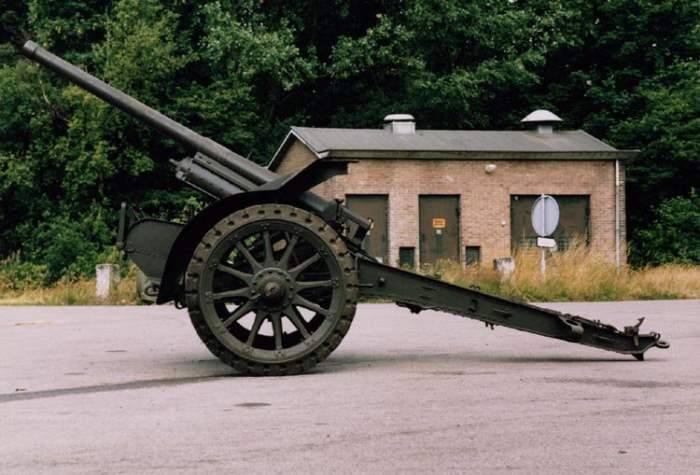
76,5 mm cannon 8 cm lehký kanon vz. thirty
In the Czechoslovak army, guns 8 cm lehký kanon vz. 30 were used in the field. At the same time, a large elevation angle and the ability to disassemble into separate parts made it possible to use them in mountainous areas.
In the German armed forces guns vz. 30 received the designation 8 cm FK 30(t). By the beginning of World War II, there were 184 such guns. The Germans also got a significant number of former Yugoslav guns, designated 7,65 cm FK 304 (j).
Guns caliber 100–150 mm
In 1914, instead of the obsolete 10 cm FH M 99 howitzer, the 10 cm FH M 14 howitzer entered service with the Austro-Hungarian army. For its time, it was a very advanced weapon that was actively used in hostilities.
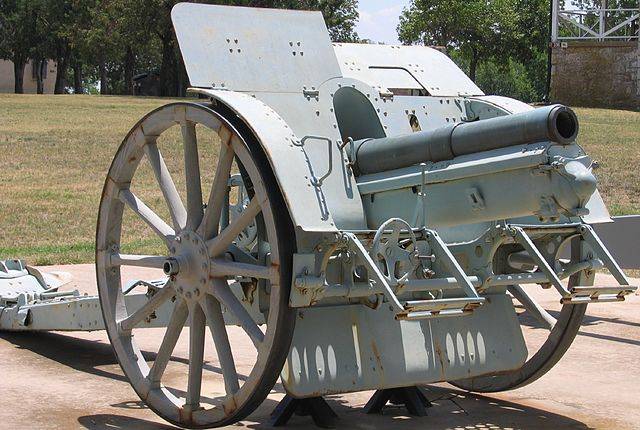
Howitzer 10 cm FH M 14
Although the gun was officially designated as 100 mm, the true caliber in reference books is 104 mm. Weight - 1 340 kg. Barrel length - 1 mm. Projectile weight - 930 kg. Initial speed - up to 14 m / s. The maximum firing range is 395 m. The rate of fire is 8 rds / min.
After modernization, the howitzer received the designation Škoda 100-mm vz. 14/19. The main improvement was the lengthening of the barrel, which increased the range of the gun to 9 m. In this version, it was produced in Czechoslovakia until 900 and was actively exported.
The Wehrmacht received more than 1 howitzers of Czech production and licensed in Poland. In 000, the Germans received 1939 howitzers and put them into service under the designation 382 cm leFH 10/14(t). The guns captured in Poland (19 units) were designated leFH 676/14(p). Captured in Greece and Yugoslavia were called leFH 19 (j) and leFH 316/14 (g).
During the First World War, Skoda produced the 100-mm howitzer 10 cm Gebirgshaubitze M. 16. This gun was designed for use in the mountains, but was usually used for fire support of infantry units on flat terrain. Before the collapse of the Austro-Hungarian Empire, the Skoda factories managed to produce approximately 550 mountain howitzers.
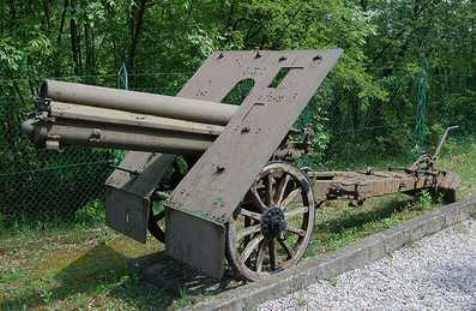
Howitzer 10 cm Gebirgshaubitze M. 16
If necessary, the gun could be disassembled into several parts. In combat position, the howitzer weighed 1 kg. Shooting was carried out with a projectile weighing 235 or 16 kg, the maximum firing range was 13,4 or 7 m, respectively. Elevation angles: -000° to +8°. Combat rate of fire - 400 rds / min.
In Czechoslovakia, a 100-mm howitzer mod. 1916 was adopted under the name 10 cm houfnice vz. 16. In 1919, the Czechoslovak army had 66 such guns. In 1920, the modernization of howitzers mod. 1916, during which they received elongated 24-caliber barrels. The mass of the gun increased by 115 kg, but this was an adequate price for increasing the firing range - it reached 9 m. The upgraded mountain howitzer received the designation vz. 800/16. In total, 19 guns were modified.
After the Nazi occupation of the Czech Republic, the Germans kept six howitzers vz. 16/19, which received the designation 10 cm GebH 16/19(t), another 38 guns went to Slovakia.
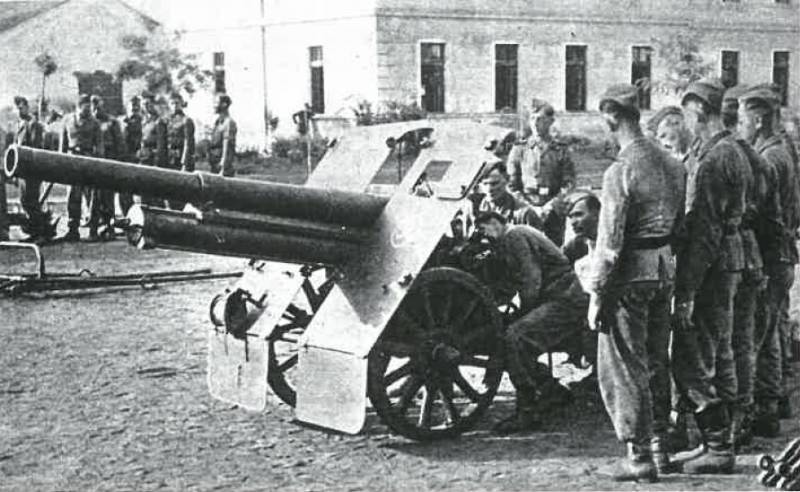
Training of German artillerymen on howitzer 10 cm GebH 16/19(t)
Short-barreled howitzers captured in Austria were designated 10 cm GebH 16(ö). In September 1943, 70 Italian howitzers, designated 10,5 cm GebH 316 (i), replenished the German artillery fleet. A number of Gebirgshaubitze M 16 served in the armies of Hungary and Romania.
With all the advantages of the 10 cm houfnice vz. 16, the military wanted to have a more long-range gun of a similar purpose. In 1927, the design bureau of the Škoda company in the city of Pilsen created the FE howitzer according to the Yugoslav order, unified on the gun carriage with the EF 76,5-mm field gun (M. 28).
After intensive testing and refinement, the Czechoslovak Ministry of National Defense ordered the first batch of howitzers in 1933, giving them the designation 10 cm lehká houfnice vzor. thirty.
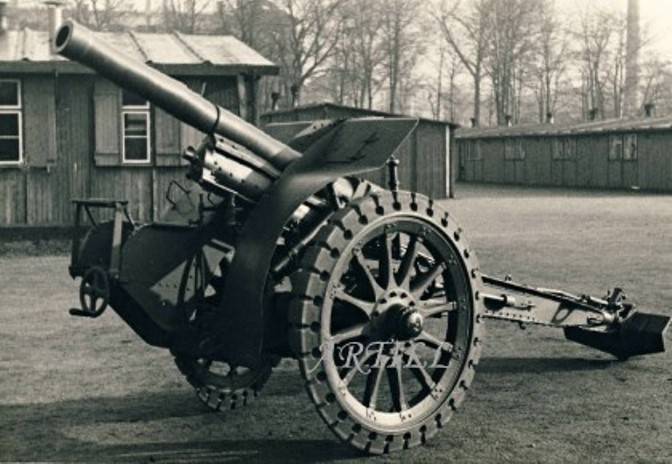
Howitzer 10 cm lehká houfnice vz. thirty
The mass of the howitzer in combat position was 1 kg. Barrel length - 798 mm. The initial speed of the projectile is up to 2 m / s. Projectile weight - 500 kg. Loading - separate-sleeve. The ammunition included shells: high-explosive fragmentation, high-explosive fragmentation with a delayed action fuse and shrapnel. In addition, the gun could fire projectiles from the vz. 430/16. The maximum firing range is 14. Elevation angles: from -19° to +10°. Rate of fire - 600 rds / min. The calculation consisted of seven people.
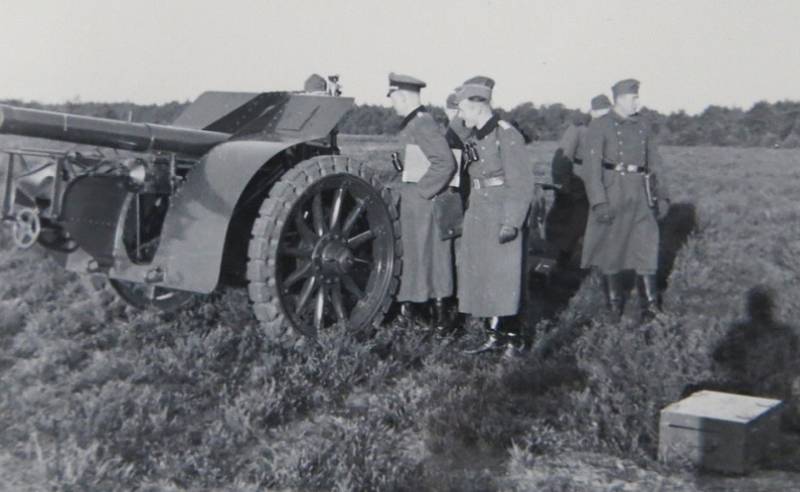
In March 1939, the Nazis captured about one and a half hundred 10-cm howitzers vz. 30, adopting them under the designation 10 cm leFH 30(t). As a means of traction, the Germans did not use cars, but three-ton half-track tractors Sd. Kfz. 11. Slovakia got 30 howitzers.
In the second half of the 1930s, Skoda specialists were actively creating new artillery systems. One of the most interesting developments was the 105 mm long-range gun, which was put into service under the designation 10.5 cm hrubý kanón vz. 35.
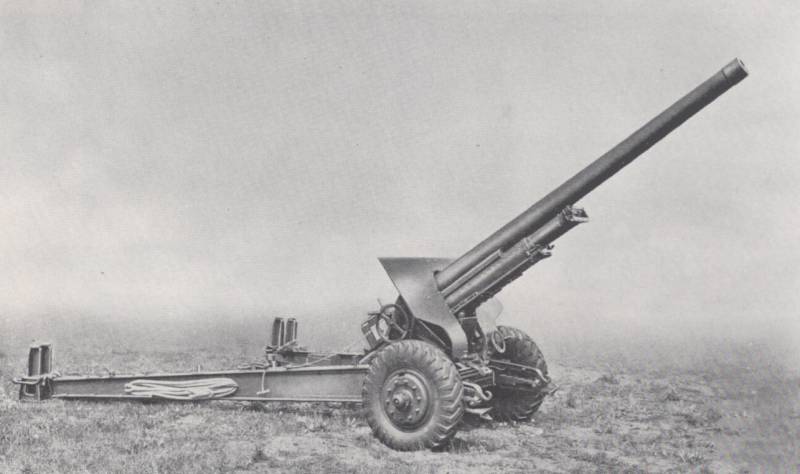
105 mm long-range gun 10.5 cm hrubý kanón vz. 35.
The main advantage of the 105-mm gun over the 100-mm howitzers was the ability to send an 18-kg projectile to a distance of 18 m, which is a good indicator even today. In a barrel length of 000 mm, the projectile could accelerate to 4 m / s. In combat position, the howitzer weighed 400 kg. Elevation angles: -730° to +4°. In the horizontal plane - 200 °. In the ammunition there were high-explosive fragmentation and armor-piercing high-explosive shells. Rate of fire - 6 rds / min.
Accurate data on the volume of production of 105-mm guns could not be found. It is known that they were in five artillery regiments of the Czechoslovak army (more than 100 units) and were delivered to Yugoslavia.
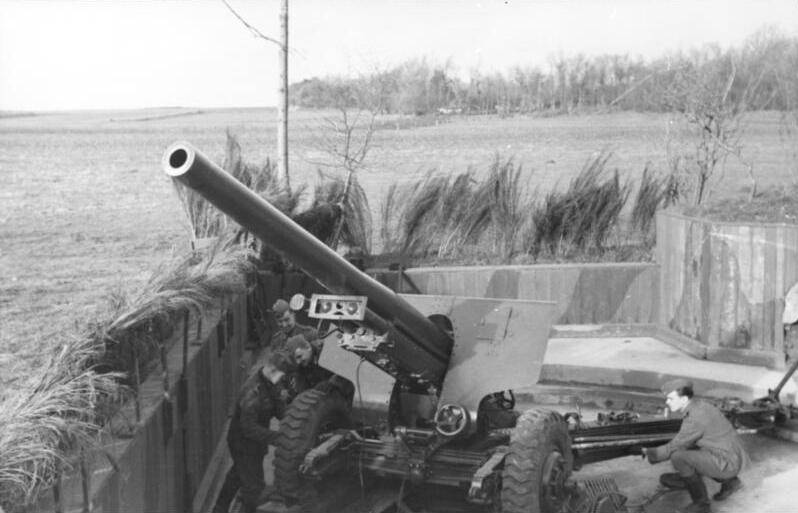
After the invasion of Czechoslovakia, the Germans took the guns for themselves, giving them the designation 10.5 cm K 35(t). Captured Yugoslav 105 mm guns were called 10.5 cm Kanone 339(j). Most of them were transferred to coastal artillery.
To destroy long-term defensive structures, a 150-mm howitzer 15 cm hruba houfnice vz was intended. 25, based on the 15 cm Autokanone M. 15/16 howitzer.
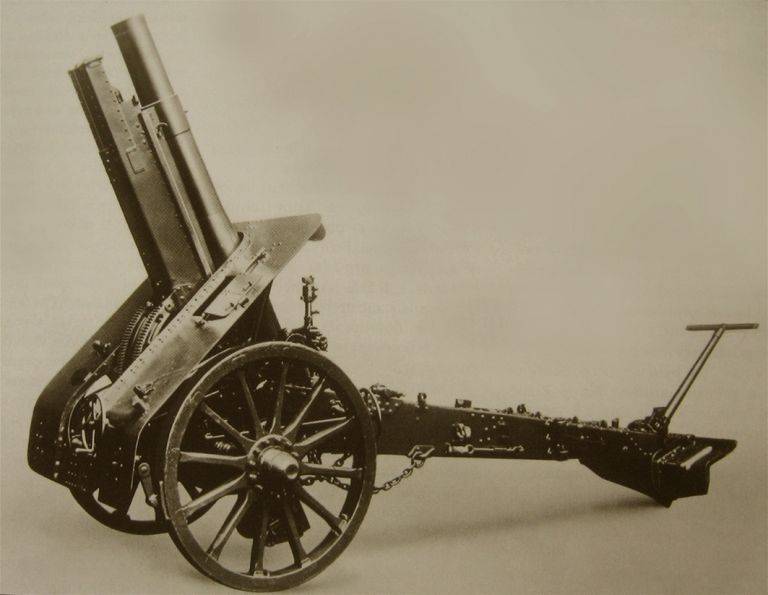
150 mm howitzer 15 cm hruba houfnice vz. 25
Weight in combat position - 3 740 kg. This was quite acceptable for the range increased to 11 m. With a barrel length of 800 mm, the maximum initial velocity of a 2-kg projectile was 700 m/s. The gun had separate loading. The range of gun aiming angles in the vertical plane ranged from -42º to +450º. In the horizontal - 5º.
In the Czechoslovak army, howitzers vz. 25 armed 12 divisions with 12 guns each - that is, the units had 144 artillery systems of this type. Almost two hundred more howitzers were in the mobilization reserve.
In March 1939, as a result of the German occupation, the Wehrmacht got 227 of these guns and almost 290 shells. The 000 mm howitzer was adopted under the designation 150 cm sFH 15(t). As of September 25, 1, the Germans had 1939 sFH 219(t) guns. Another 25 howitzers went to Slovakia.
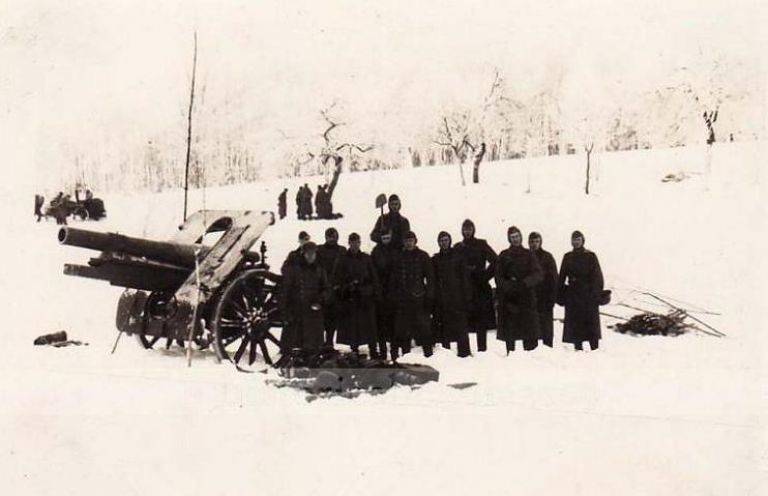
It is interesting to compare the 150 cm Czech howitzer vz. 25 with the German 15 cm sFH 18 howitzer, which had a one and a half kilometer greater firing range and, thanks to the use of a carriage with sliding beds, a much greater range of horizontal guidance angles. At the same time, the Czechoslovak howitzer in combat position weighed a third less than the sFH 18.
In 1933, the Skoda company began producing 150-mm K-series guns, which were successfully sold to Turkey, Romania and Yugoslavia. The modernized version of the "K4", which entered service with the Czechoslovak army, had the designation 15 cm hruba houfnice vz. 37.
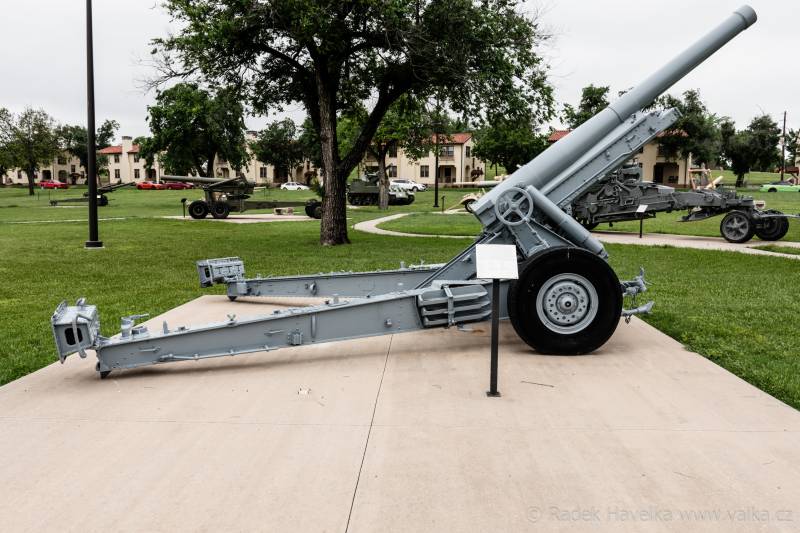
150 mm howitzer 15 cm hruba houfnice vz. 37
The 150-mm gun, which was put into service in Czechoslovakia, differed from the early model in a lightweight design. In accordance with modern requirements, new howitzers were produced with wheels equipped with pneumatic tires, which made it possible to use mechanized traction.
Weight in combat position - 5 200 kg. Barrel length - 3 600 mm. Elevation angles: -5° to +70°. In the horizontal plane - 42 °. Projectile weight - 42 kg. Initial speed - up to 580 m / s. Maximum range - up to 15 m. Rate of fire - 000 rds / min. Calculation - 3 people.
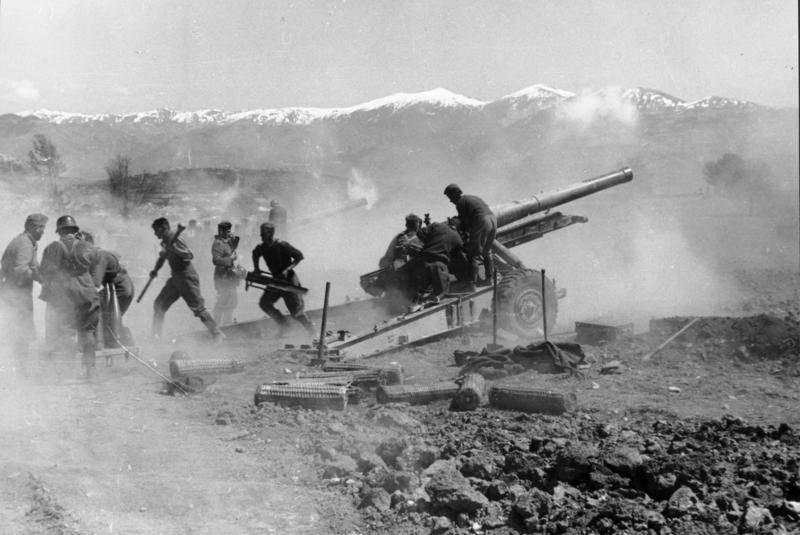
The Germans liked the gun, its production and the release of ammunition continued after the occupation. In the Wehrmacht, a modification of the Czech howitzer received the designation sFH 37 (t). Yugoslav howitzers were called sFH 402(j). The combat debut of the guns took place in the Balkans. Until 1944, they were actively used on the Eastern Front, in 1944 the surviving howitzers were transferred to the West.
Продолжение следует ...
- Linnik Sergey
- Czech small arms in service with Nazi Germany
Czech machine guns in the armed forces of Nazi Germany
Czech anti-aircraft guns in the air defense of Nazi Germany
Information